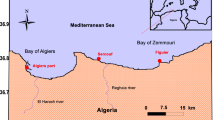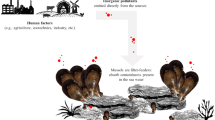Abstract
Seasonal changes in metal (Cu, Fe, Mn, Pb, and Zn) concentrations were observed in the digestive gland of the Mediterranean mussel, Mytilus galloprovincialis, from both a polluted and a non-polluted population. Digestive gland of mussels from the polluted site showed metal concentrations appreciably higher than in non-polluted organisms, especially for Pb (up to 160 μg/g d.w.), Mn (up to 300 μg/g d.w.), and Fe (up to 8,500 μg/g d.w.), whereas the two populations showed maximum mean values, respectively, of 34 and 20 μg/g d.w. for Cu and 170 and 120 μg/g d.w. for Zn.
Over 1 year (1991), differences between maximum and minimum values were moderate only in the unpolluted organisms. During gametogenesis, while the metal concentrations (expressed as μg/g dry weight) decreased in the digestive gland, the tissue burden (as μg) in that organ remained nearly constant or increased slightly.
The apparent decrease in metal concentrations was probably due to the penetration of gonadic tissues into the digestive gland during gametogenesis, which biologically diluted metal concentrations in mussels from both the polluted and unpolluted populations. The effect of mussel size on trace metal concentrations in the digestive gland was demonstrated during different stages of the reproductive cycle. Higher concentrations were found in smaller organisms; however, during the spawning period, due to the fact that this is not a synchronous process within a population, the organisms exhibit a high variability in digestive gland weight which can mask this relationship when digestive gland weight is used as a size-index and as a parameter of the trace metal digestive gland burden.
Similar content being viewed by others
References
Amiard JC, Amiard-Triquet C, Berthet B, Métayer C (1986) Contribution to the ecotoxicological study of cadmium, lead, copper, and zinc in the mussel Mytilus edulis. I. Field study. Mar Biol 90:425–431
Amiard-Triquet C, Berthet B, Métayer C, Amiard JC (1986) Contribution to the ecotoxicological study of cadmium, copper and zinc in the mussel Mytilus edulis. II. Experimental study. Mar Biol 92:7–13
Bayne BL (1976) Marine mussels: Their ecology and physiology. Cambridge University Press, Cambridge
Boalch R, Chan S, Taylor D (1981) Seasonal variation in the trace metal content of Mytilus edulis. Mar Pollut Bull 12:276–280
Boyden CR (1974) Trace element content and body size in molluscs. Nature 251:311–314
— (1977) Effect of size upon metal content of shellfish. J Mar Biol Assoc UK 57:675–714
Chambers JE, McCorkle FM, Carroll JR, Heitz JR, Lewis L, Yarbrough JD (1975) Variation in the enzyme activities of the American Oyster (Crassostrea virginica) relative to size and season. Comp Biochem Physiol 51B:145–150
Cossa D, Bourget E, Pinze J (1979) Sexual maturation as a source of variation in the relationship between cadmium concentration and body weight of Mytilus edulis. Mar Pollut Bull 10:174–176
Cossa D, Bourget E, Pouliot D, Pinze J, Chanut JP (1980) Geographical and seasonal variations in the relationship between trace metal content and body weight in Mytilus edulis. Mar Biol 58:7–14
Davies IM, Pirie JM (1980) Evaluation of a “Mussel Watch” project for heavy metals in Scottish coastal waters. Mar Biol 57:87–93
Farrington JW, Goldberg ED, Risebrough RW, Martin JH, Bowen VT (1983) U.S. “Mussel Watch” 1976–1978: An overview of the trace metals, DDE, PCB, hydrocarbon, and artificial radionuclide data. Environ Sci Technol 17:490–496
Fisher H (1983) Shell weight as an independent variable in relation to cadmium content of molluscs. Mar Ecol Prog Ser 12:59–75
Fowler SW, Oregioni B (1976) Trace metals in mussels from the N. W. Mediterranean. Mar Pollut Bull 7:26–29
George SG, Coombs TL (1975) A comparison of trace metal and metalloenzyme profiles in different molluscs and during development of the oyster. In: Barnes H (ed) Proceedings of the 9th European marine biology symposium. Aberdeen University Press, Aberdeen, pp 433–449
—, — (1977). The effects of chelating agents on the uptake and accumulation of cadmium by Mytilus edulis. Mar Biol 39:261–268
Goldberg ED (1975) The Mussel Watch. A first step in global marine monitoring. Mar Pollut Bull 6:111
— (1980). The international Mussel Watch. National Academy of Sciences, Washington, DC
— (1986) The Mussel Watch concept. Environ Monitor Assessm 7:91–103
Hochachka PW, Mustafa T (1972) Invertebrate facultative anaerobiosis. Science 178:1056–1060
Klumpp DW, Burdon-Jones C (1982) Investigations of the potential of bivalve molluscs as indicators of heavy metal levels in tropical marine waters. Aust J Mar Freshwater Res 33:285–300
La Touche YD, Mix MC (1982a) Seasonal variation of arsenic and other trace elements in bay mussels (Mytilus edulis). Bull Environ Contam Toxicol 29:665–670
—, — (1982b) The effects of depuration, size and sex on trace metal levels in bay mussels. Mar Pollut Bull 13:27–29
Leonzio C, Bacci E, Focardi S, Renzoni A (1981) Heavy metals in organisms from the northern Tyrrhenian Sea. Sci Total Environ 20:131–146
Lewis AG, Cave WR (1982) The biological importance of copper in oceans and estuaries. Oceanogr Mar Biol A Rev 20:471–695
Lobel PB, Wright DA (1982) Gonadal and nongonadal zinc concentrations in mussels. Mar Pollut Bull 13:320–323
Lobel PB, Bajdik CD, Belkhode SP, Jackson SE, Longerich HP (1991) Improved protocol for collecting Mussel Watch specimens taking into account sex, size, condition, shell shape, and chronological age. Arch Environ Contam Toxicol 21:409–414
Lulic S, Strohal P (1974) The application of neutron activation analysis in studying the marine pollution processes. Rev Int Océanogr Méd 33:119–123
Majori L, Nedoclan G, Modonutti GB, Daris F (1978) Study of seasonal variations of some trace elements in the tissue of Mytilus galloprovincialis taken in the Gulf of Trieste. Rev Int Océanogr Méd 49:37–40
Mauri M, Orlando E (1983) Variability of zinc and manganese concentrations in relation to sex and season in the bivalve Donax trunculus L. Mar Pollut Bull 14:342–346
Orren MJ, Eagle GA, Hennig HF-KO, Green A (1980) Variation in trace metal content of the mussel Choromytilus meridionalis (Kr.) with season and sex. Mar Pollut Bull 11:253–257
Pentreath RJ (1973) The accumulation from water of 65Zn, 54Mn, 60Co and 59Fe by the mussel, Mytilus edulis. J Mar Biol Assoc UK 53:127–143
Phillips DJH (1976) The common mussel Mytilus edulis as an indicator of pollution by zinc, cadmium, lead and copper. I. Effects of environmental variables on uptake of metals. Mar Biol 38:59–69
— (1977) Effects of salinity on the net uptake of zinc by the common mussel Mytilus edulis. Mar Biol 41:79–88
— (1980) Quantitative aquatic biological indicators: Their use to monitor trace metal and organochlorine pollution. Applied Science Publishers Ltd, London
Phillips DJH, Yim WW-S (1981) A comparative evaluation of oysters, mussels and sediments as indicators of trace metals in Hong Kong waters. Mar Ecol Prog Ser 6:285–293
Phillips DJH, Segar DA (1986) Use of bioindicators in monitoring conservative contaminants: programme design imperatives. Mar Pollut Bull 17(1):10–17
Phillips DJH, Rainbow PS (1988) Barnacles and mussels as biomonitors of trace elements: a comparative study. Mar Ecol Prog Ser 49:83–89
Popham JD, d'Auria JM (1983) Combined effect of body size, season and location on trace element levels in mussel (Mytilus edulis). Arch Environ Contam Toxicol 12:1–14
Regoli F (1992) Lysosomal responses as a sensitive stress index in biomonitoring heavy metal pollution. Mar Ecol Prog Ser 84:63–69
Regoli F, Orlando E, Mauri M, Nigro M, Alfinito Cognetti G (1991) Heavy metal accumulation and calcium content in the bivalve Donacilla cornea. Mar Ecol Prog Ser 74:219–224
Regolif F, Orlando E (1993) Mytilus galloprovincialis as a bioindicator of lead pollution: biological variables and cellular responses. Sci Total Environ Suppl(2):1283–1292
--,--(1994a) Bioavailability of “biologically detoxified” lead: risks arising from consumption of polluted mussels. Environ Health Persp (in press)
--,--(1994b) Accumulation and subcellular distribution of metals (Cu, Fe, Mn, Pb and Zn) in the Mediterranean mussel Mytilus galloprovincialis during a field transplant experiment. Mar Pollut Bull (in press)
Renzoni A (1963) Ricerche ecologiche ed idrobiologiche su Mytilus galloprovincialis Lam. nel Golfo di Napoli. Boll Pesca Pisc Idrobiol 18:187–238
— (1980) Shellfish and heavy metals in the Mediterranean. Thalassia Jugosl 16:335–346
Scholz N (1980) Accumulation, loss and molecular distribution of cadmium in Mytilus edulis. Helgoländer Wiss Meeresunters 33:68–78
Schulz-Baldes M (1974) Lead uptake from seawater and food, and lead loss in the common mussel Mytilus edulis. Mar Biol 25:177–193
Seed R (1976) Ecology. In: Bayne BL (ed) Marine mussels: Their ecology and physiology. Cambridge University Press, Cambridge, pp 13–65
Sheppard CRC, Bellamy DJ (1974) Pollution of Mediterranean around Naples. Mar Pollut Bull 5:42–44
Simpson RD (1979) Uptake and loss of zinc and lead by mussels (Mytilus edulis) and relationships with body weight and reproductive cycle. Mar Pollut Bull 10:74–78
Thompson RJ, Ratcliffe NA, Bayne BL (1974) Effects of starvation on structure and function in the digestive gland of the mussel Mytilus edulis L.). J Mar Biol Assoc UK 54:699–712
Viarengo A (1989) Heavy metals in marine invertebrates: mechanisms of regulation and toxicity at the cellular level. CRC Critical Rev Aquat Sci 1(2):295–317
Author information
Authors and Affiliations
Rights and permissions
About this article
Cite this article
Regoli, F., Orlando, E. Seasonal variation of trace metal concentrations in the digestive gland of the Mediterranean mussel Mytilus galloprovincialis: Comparison between a polluted and a non-polluted site. Arch. Environ. Contam. Toxicol. 27, 36–43 (1994). https://doi.org/10.1007/BF00203885
Received:
Revised:
Issue Date:
DOI: https://doi.org/10.1007/BF00203885




